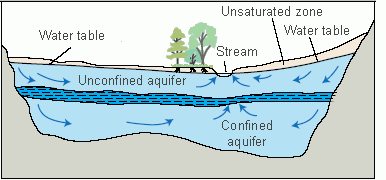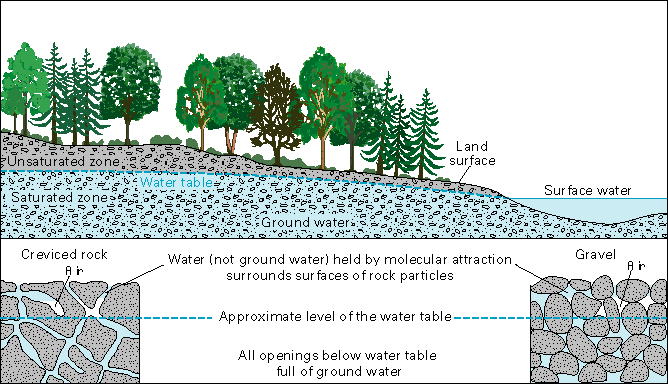An aquifer is the water-saturated mass of gravel, rocks, or earth where the water flows freely. The water in this subsurface zone may be tapped with a well to supply fresh drinking water. Most rural homes, and some cities, depend on well water for their water supply.
The saturated zone is where all the subsurface spaces or pores in the soil are filled with water. The bottom of the saturated zone may be de
nse bedrock that allows little water to penetrate further downward.
 The water table is the top of the saturated zone. The water table moves up and down with the seasons and with water usage.
The water table is the top of the saturated zone. The water table moves up and down with the seasons and with water usage.
The unsaturated zone is between the soil surface and the water table, where pores in the soil are filled with air and water. Water not held by soil or subsurface layers passes through this zone.
Recharge water seeps through the unsaturated zone into the aquifer or saturated zone.
The permeability of a soil is a measure of the rate at which water flows through it.
Permeable soils allow water to flow through.
Impermeable soils allow little to no infiltration.
Recharge zones of permeable soils, rock, and other subsurface layers allow water to seep downward into aquifers. Before soil water can move to the groundwater, the water-storage capacity of the soil must be exceeded.
A soil’s field capacity can be compared with a cup. Once the cup is full, it cannot hold more water. If the soil is already at field capacity when it rains, or when irrigation water enters the soil, the water that cannot be held in the soil will contribute to recharge. Water from streams, rivers, and lakes may also recharge the groundwater. This typically happens when the water table drops below the level of adjacent surface water sources.
A cone of depression is created when pumping water from a well creates an area of unsaturated soil near the well. Groundwater surrounding the well moves horizontally to fill the unsaturated area. The shape of the gap is similar to an upside down cone, with the deepest part near the well. The cone of depression may extend far from the well. When this is the case, groundwater may move long distances to replace water removed from the well.
Induced recharge occurs when water from a surface source is “pulled” into the flow of water in the cone of depression. Induced recharge can draw contaminants such as pesticides into the well.
Leaching is the movement of contaminants, such as water-soluble pesticides or fertilizers carried by water downward through permeable soils. A plume is a volume of contaminated groundwater that continues to move underground in the same direction and speed as the surrounding groundwater.
A plume is a volume of contaminated groundwater that continues to move underground in the same direction and speed as the surrounding groundwater. A plume can travel a long way as the groundwater moves to its discharge points. The plume will add contaminated water to every discharge point along its path, including wells.
Persistence is a measure of how long a chemical remains in the environment.
Runoff is the movement of water and any contaminants across the soil surface.
Erosion is the scouring action and molding of all landforms on the Earth’s surface, including the weathering of rock by wind and water, and the transport of weathered material.
Additional Information
- USGS Water Basics Glossary — An extensive list of terms used in the water resources area.
Original content compiled by:

